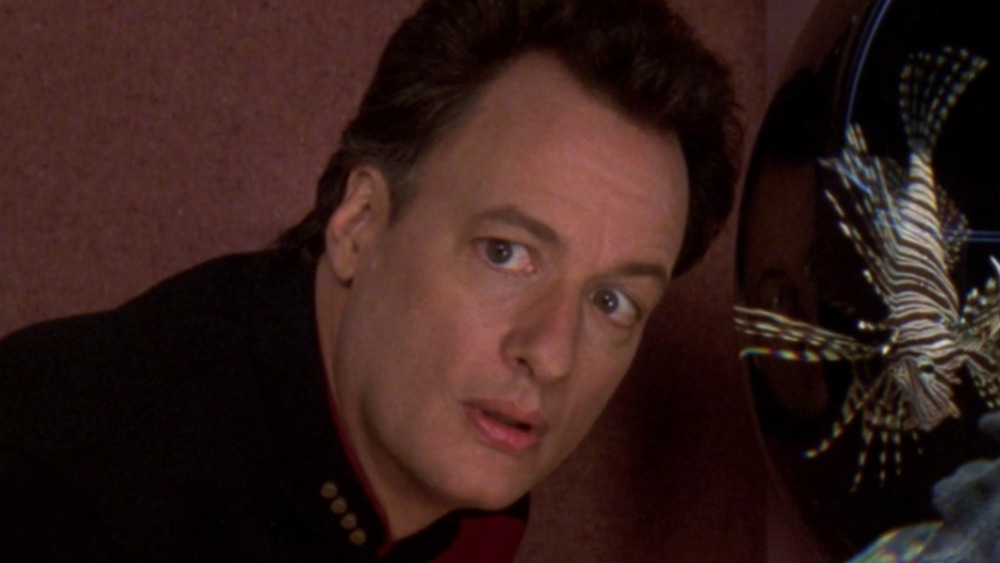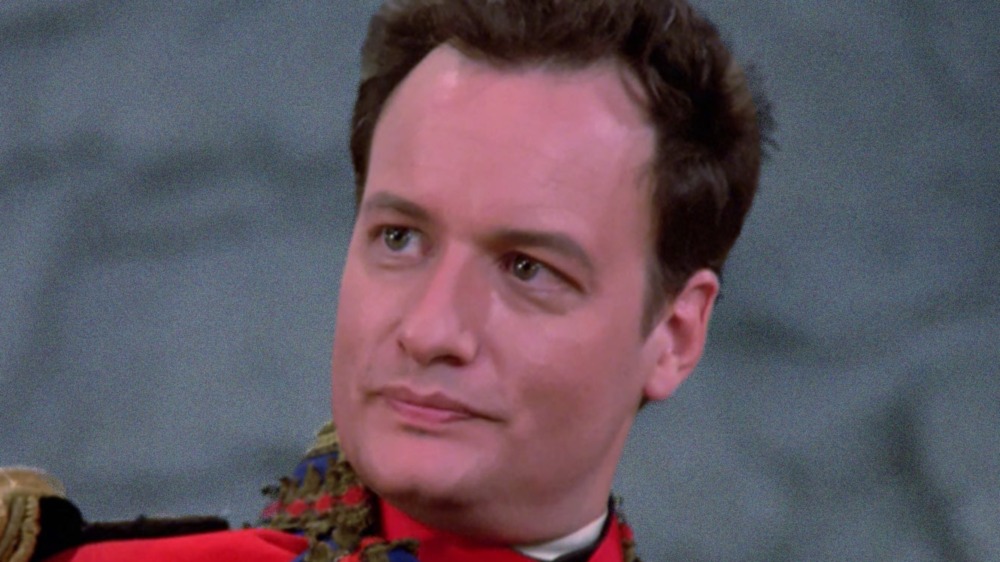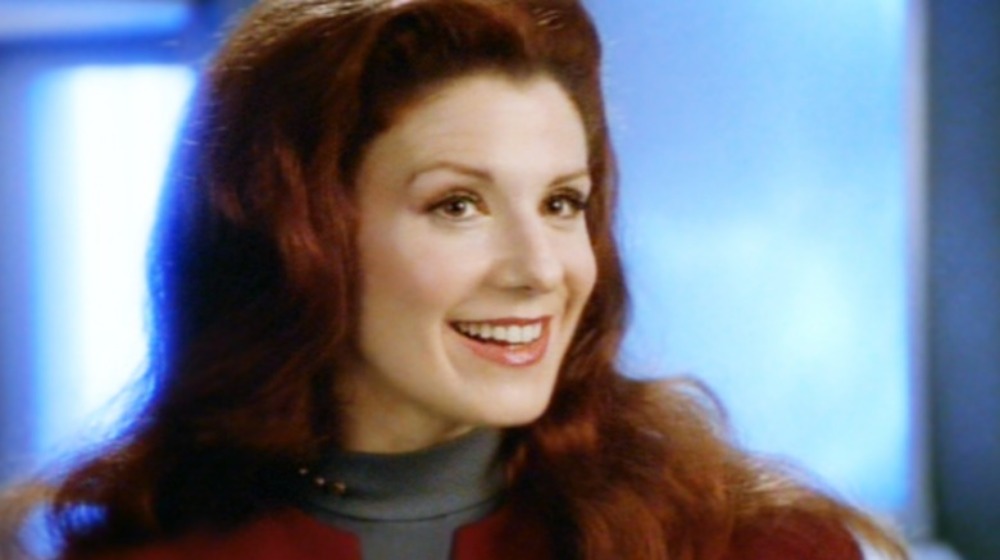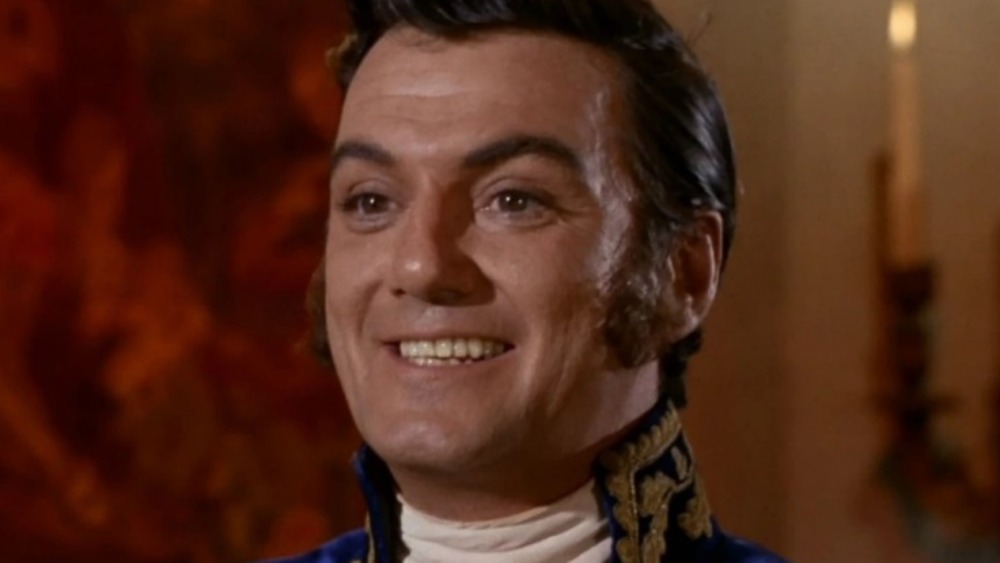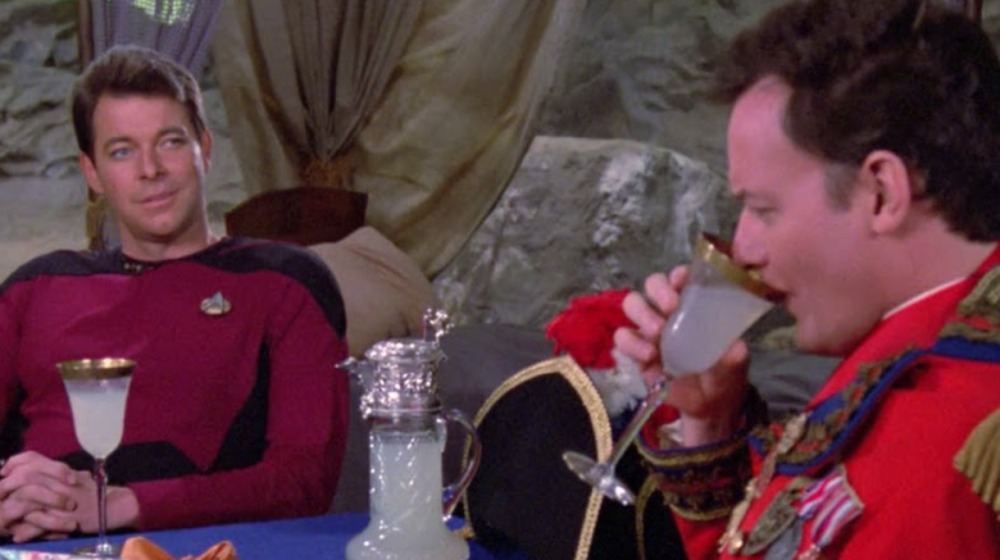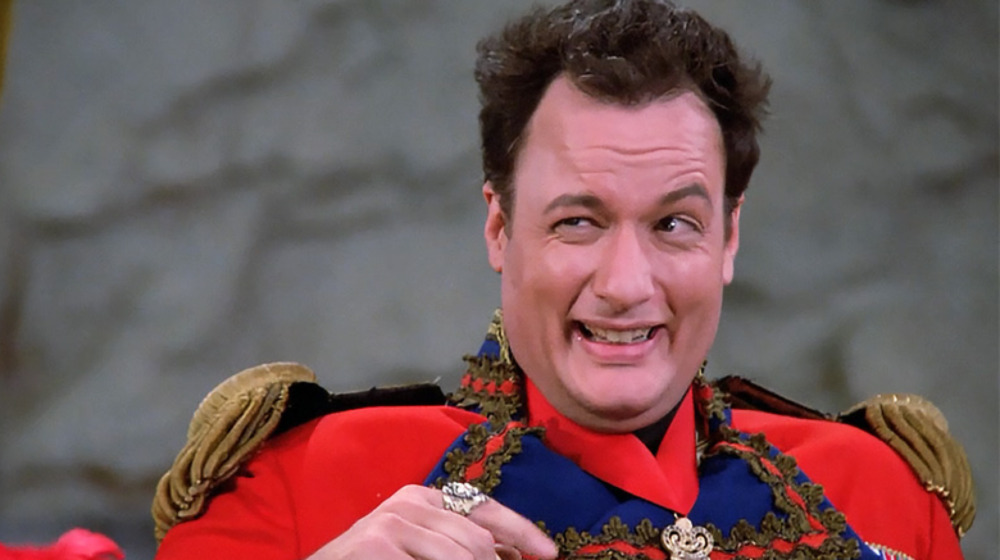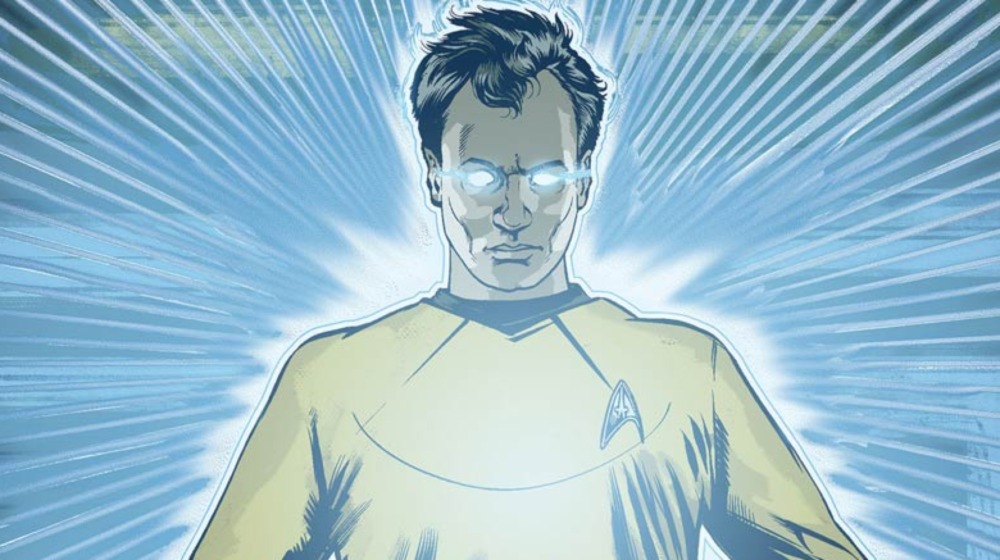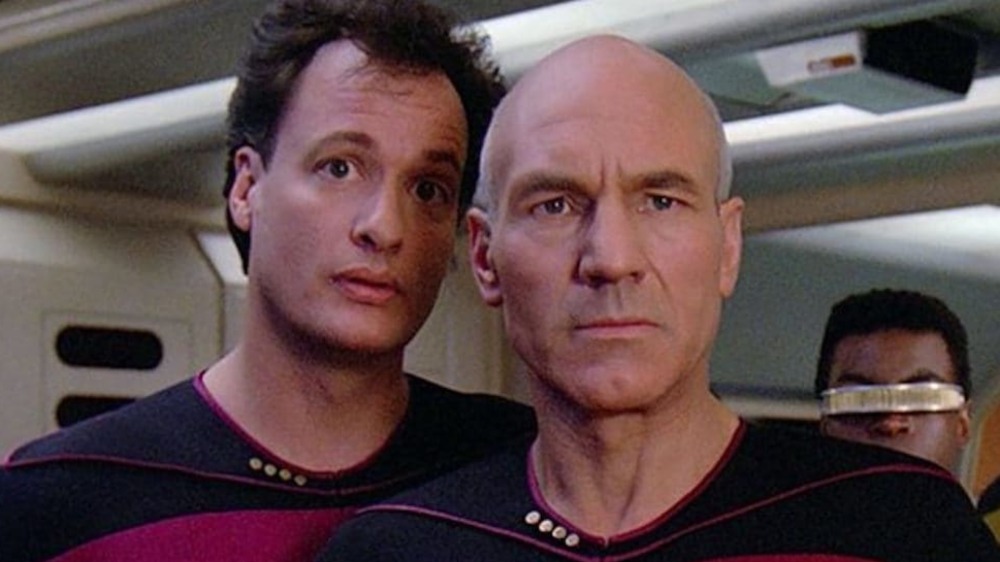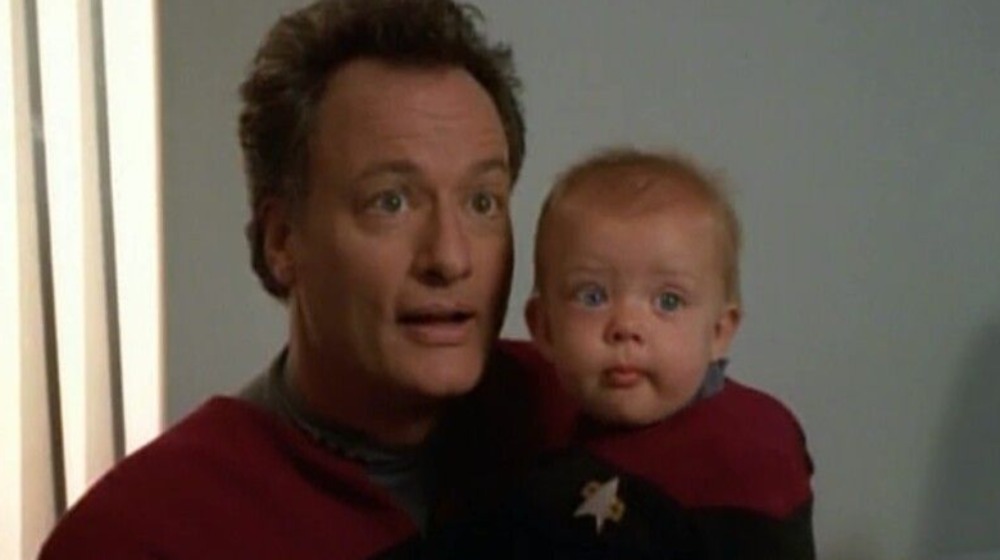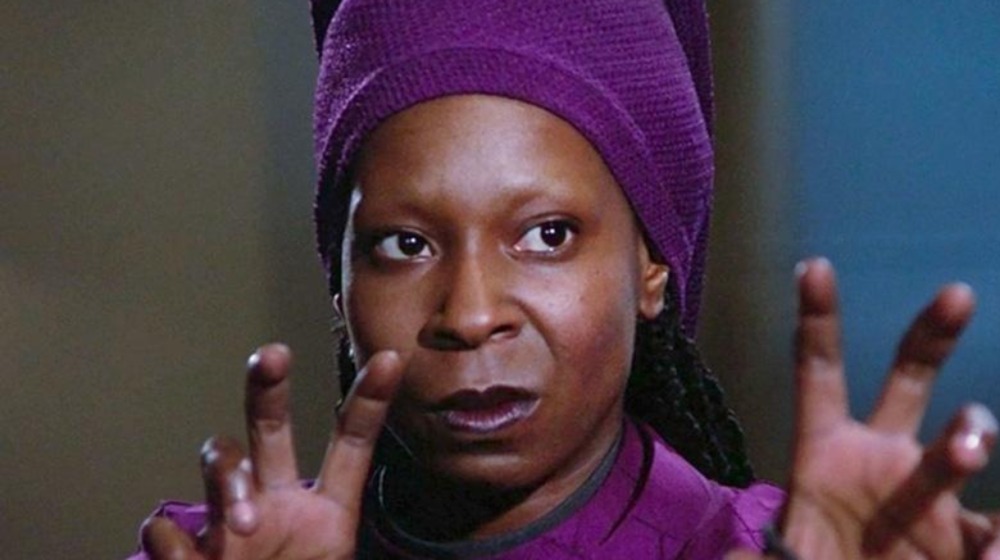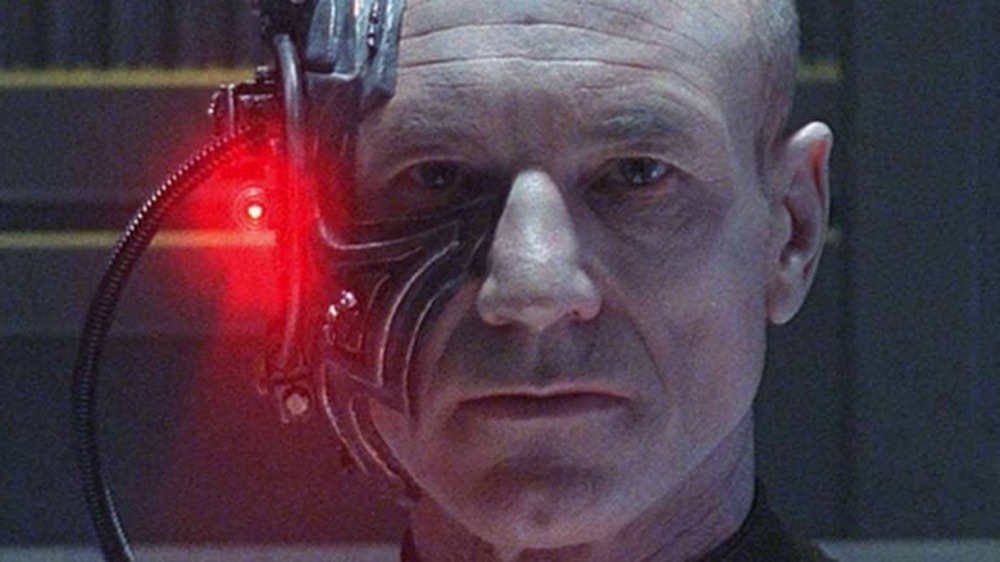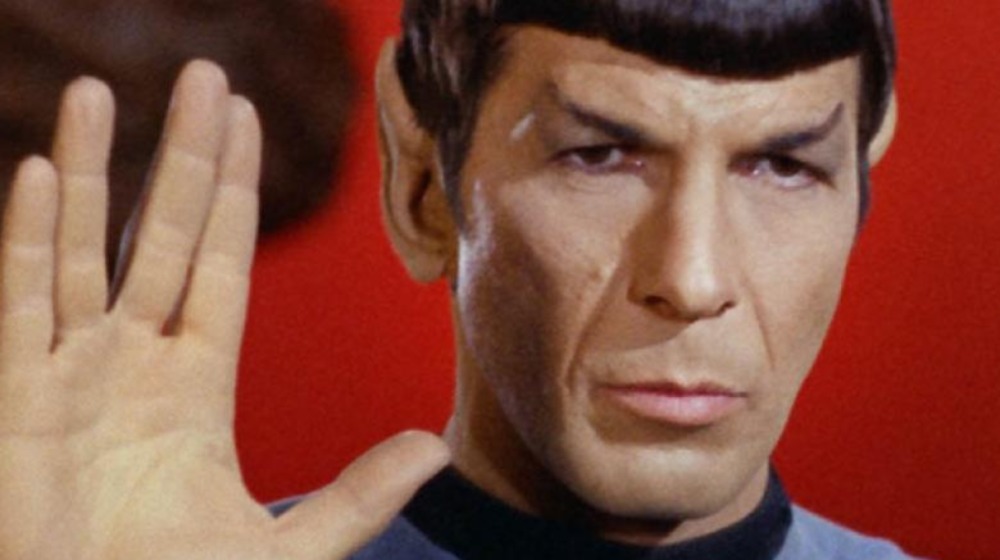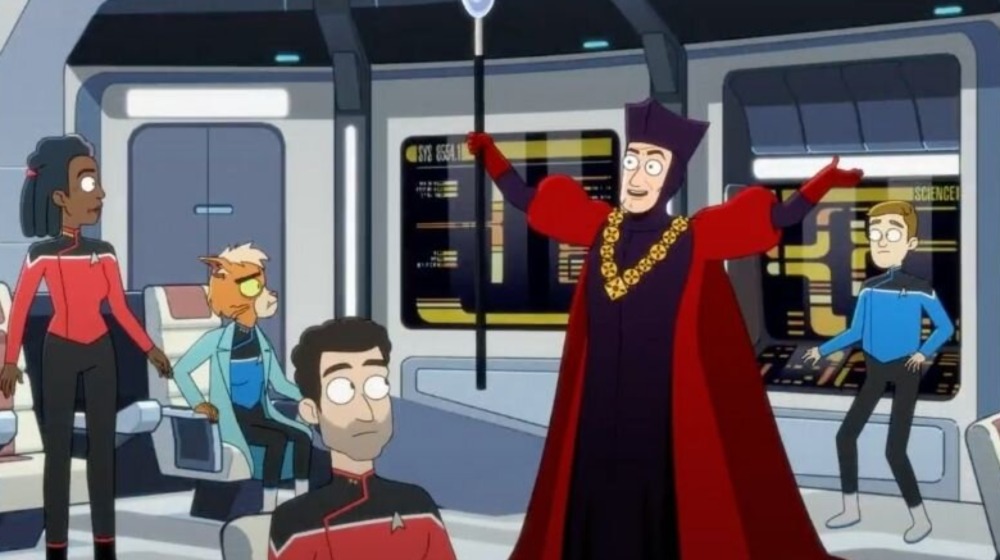The Untold Truth Of Q From Star Trek
He's an enigmatic, seemingly omnipotent being who manipulates people like they're chess pieces. He's a mischievous trickster who can go anywhere and be anything in our three-dimensional space. He's Q — no other name necessary — and he's proven himself to be both a great ally and antagonist within the Star Trek franchise.
Played by classically trained actor John de Lancie, Q is easily one of Star Trek's most iconic creations — even though he's only appeared in 13 episodes to date in multiple Star Trek television series. Nevertheless, it sometimes seems Q is everywhere, thanks to all the Star Trek novels, comics, audio books, and video games he's popped up in.
With John de Lancie set to reappear as Q in season 2 of Star Trek: Picard, now's a perfect time to get up close and personal with this omnipotent trickster and find out what makes him tick. Be warned though: de Lancie himself has claimed that Q, much like the infamous English poet Lord Byron, is "mad, bad, and dangerous to know." With that in mind, let's delve into the many secrets of Star Trek's Q.
Q is named after a Star Trek fan
At first glance, Q's name seems ridiculously simple. It's just one letter — how hard could it have been to come up with? But according to the 4th edition of the Star Trek Encyclopedia, the story behind Q's designation has a curious link with the Star Trek fandom.
Q was named by none other than Star Trek creator Gene Roddenberry, who chose the unusual alias in honor of his friend Janet Quarton. A long-time Star Trek fan, Quarton was the president of the Star Trek Action Group (STAG), an early Star Trek fan club. She also helped publish Star Trek fanzines and organize Star Trek conventions in Britain. Her involvement in the Star Trek fan community caught the attention of Gene Roddenberry who corresponded closely with Quarton over the years.
Later, when Roddenberry helmed Star Trek: The Next Generation, he decided to name the new series' first antagonist after the last initial of his friend — and John de Lancie was dubbed "Q" for the series' pilot episode "Encounter at Farpoint." Given how much future Star Trek fandom would embrace the superbeing, it seems only appropriate that a fan helped name him.
He's not the only Q
John de Lancie may be the face of Q for Star Trek fans, but the truth is he's not the only member of his species — nor do all members of the Q act like him. Over the years, fans have seen many different "Q" entities who all belong to the "Q Continuum," an extra-dimensional plane of existence.
Where de Lancie's Q comes across as a trickster figure, other Qs are more benevolent. In the Star Trek: Voyager season 2 episode "Death Wish," the crew of the U.S.S. Voyager encounters a Q who's been subtly influencing human society for the better — making sure an apple fell on Sir Isaac Newton's head to inspire his theory of gravity and saving Commander William Riker (Jonathan Frakes)'s ancestor during the Civil War. Other Q members prefer to live quietly, including a couple who disguised themselves as humans and had a daughter, Amanda Rogers (Olivia d'Abo), in the Star Trek: The Next Generation season 6 episode "True Q."
In fact, in "Death Wish," it's revealed that most of Q society is bored with their immortality and power, which helps explain why de Lancie's Q likes hanging out with human beings so much — they're much more fun than his own people.
Q is very similar to a classic Star Trek antagonist
When Gene Roddenberry first came up with the idea to put Q in the pilot episode of Star Trek: The Next Generation, other members of the writing team hated the character and advised him not to use him in the pilot.
Why? According to the Star Trek reference book, The Fifty-Year Mission: The Next 25 Years — From the Next Generation to J.J. Abrams, the team saw Q as a copy of Trelane, a character who appears in the original Star Trek season 1 episode "The Squire of Gothos." In the story, Captain Kirk and his crew encounter a powerful alien named Trelane (William Campbell) who makes the Enterprise crew his playthings. Although Trelane appears all-powerful, we learn he's the child of two other omnipotent beings who make him stop bothering the U.S.S. Enterprise.
While similar to Trelane, both Roddenberry and de Lancie worked to make Q a unique entity. Nevertheless, fans continue to see the parallels and non-canon Star Trek media makes links between the two. In his novel Q-Squared, writer Peter David reveals Trelane is, in fact, another member of the Q Continuum. Then in the Star Trek comic book storyline "The Q Conflict," Q assembles a team of omnipotent beings including Trelane to make multiple Star Trek crews battle in a cosmic-level game.
Q can make other people omnipotent
Q's powers are immense, which he's repeatedly demonstrated throughout his appearances throughout the Star Trek franchise. With a snap of his fingers, Q can teleport himself and anyone else to any place or time. He can rewrite the very fabric of our universe — moving asteroids or even creating pocket realities. And he's nearly omniscient, claiming in the Star Trek: The Next Generation season 3 episode "Deja Q" that he has "an IQ of 2005."
And thanks to his powers, Q can give anyone the abilities of a god — which he does to Commander William Riker in the Star Trek: The Next Generation season 1 episode "Hide and Q." Riker gains the ability to transport his crew mates anywhere he wants without relying on their usual transporter technology. He resurrects Worf (Michael Dorn) from the dead, ages teenager Wesley Crusher (Will Wheaton) to an adult, and even gives blind Geordi LaForge (LeVar Burton) natural vision.
However, every member of the Enterprise rejects Riker's "gifts" (although Worf does get to stay alive), causing Riker to reject his new powers. And it's a good thing too. Q only gave Riker god-like abilities as part of a bet he had with Captain Jean-Luc Picard (Patrick Stewart). By choosing not to be a Q-level entity, Q is forced to leave the Enterprise alone — although he does find enough loopholes to make multiple return visits.
Q isn't all-powerful
While Q might appear to be an all-knowing and all-powerful god to some, the truth is he doesn't have limitless powers. Other members of the Q Continuum can overpower Q or even strip him of his powers, as they did in the episode "Deja Q" by turning him into an ordinary human being with back problems.
In the Star Trek: The Next Generation season 4 episode "Qpid," Q transports the Enterprise crew to a pocket reality where Picard becomes Robin Hood, his crew becomes his Merry Men, and Q himself adopts the guise of the Sheriff of Nottingham. As he explains the rules of his new game, Q reveals that he's given this reality a life of its own and not even he can predict what will happen. This shows that Q is not omnipotent or omniscient, as a truly all-powerful being could not create something capable of overpowering or outsmarting him.
Indeed, this quasi-omnipotence may be the one saving grace for the Q, as involving themselves in games of chance gives them the thrill of not knowing what will happen next.
Star Trek's Q once became super-omnipotent
Q may have been at the mercy of the Q Continuum in many of his early appearances, but a non-canonical comic book storyline shows that he once became super-omnipotent — thanks to J.J. Abrams Star Trek reboot.
In the IDW Star Trek story "The Q Gambit," Q journeys to the Kelvin timeline of the Abrams' films where the younger alternate versions of Captain Kirk and Spock are having their own adventures. Q transports the crew forward into the future where they meet alternate versions of Benjamin Sisko and the crew from Star Trek: Deep Space Nine.
Although this seems to be another one of Q's games, the trickster later reveals the Q-Continuum is in a war against another extra-dimensional race, the malevolent Deep Space Nine villains, the Pah-Wraiths, whose power allows them to fight the Q. To stop them, Spock engineers a situation where Q merges with a member of the Pah-Wraiths' ancient enemy The Prophets. Q evolves into a supremely powerful being who eliminates the Pah-Wraiths with a wave of his hand, and then pops back into the Prime Star Trek universe to show off his super-godly powers to Jean-Luc Picard.
Let's be real: Q is in love with Jean-Luc Picard
Jean-Luc Picard may treat Q with annoyance, but Q has a unique affection for Picard. In "Deja Q," Q admits, "in all the universe, you're the closest thing I have to a friend, Jean-Luc." Data (Brent Spiner) also observes in the Star Trek: The Next Generation series finale "All Good Things..." that, "Q's interest in you has always been very similar to that of a master and his beloved pet" before hastily adding, "That was only an analogy, Captain."
However, in the season 6 episode "Tapestry," Q indicates his interest in Picard goes beyond mere fondness when he shows up in Picard's bed and wakes him with the words, "Morning, darling." The same episode has Q transport a dying Picard back to his Starfleet Academy days so the captain can gain a better appreciation for the mistakes of his past. This indicates Q views himself as Picard's guardian angel, albeit an impish one, who has a special love for the one he calls "Mon Capitane."
Screenwriter Ron Moore agrees, noting in Star Trek: The Official Starships Collection #90 that, "Q was in love with Picard, for some reason. That was the underpinning of the relationship... The weird love affair that he had going with Jean-Luc made that whole thing work."
Q is a lousy boyfriend and father
Sadly, when it comes to showing affection, Q's ego inevitably gets in the way of his relationships. In the Star Trek: Voyager season 3 episode "The Q and the Grey," Q's girlfriend "Lady Q" (Suzie Plankson) shows up when Q flirts with Captain Kathryn Janeway (Kate Mulgrew). The two have been a couple for four billion years, but Q emphasizes, "I never said it was exclusive" while bragging that he uses his omnipotence to seduce females across the galaxy.
In the episode, Q and his girlfriend are on opposite sides of a Q civil war, causing their relationship problems to threaten the universe with multiple supernova explosions. Q's idea to end the war is to impregnate Janeway and adding human DNA to the Continuum — an idea the Voyager captain roundly rejects. However, Janeway convinces Q to have a child with Lady Q instead, leading to a truce between the two factions.
Unfortunately, Q turns out to be a lousy father and in the Star Trek: Voyager season 7 episode "Q2," his son "Q Junior" (played by de Lancie's real-life son Keegan de Lancie) becomes a juvenile delinquent who starts wars, tampers with gene pools, and punches holes in space time. To get him to reform, Q strips Junior of his powers and dumps him on Voyager, where Junior makes friends and learns to value life. While this is good for the universe, it shows Q still tries to get other people to solve his problems instead of dealing with them himself.
Q really hates the Enterprise's bartender (and she hates him back)
Q's antics have earned him plenty of enemies across the universe, but oddly enough, one of the people who hates him the most is the Enterprise's beloved bartender Guinan (Whoopi Goldberg). One of Star Trek: The Next Generation's most serene and level-headed characters, Guinan reveals in "Q Who" that she has had "some dealings" with Q during the 22nd century that left them enemies. Q himself dislikes Guinan, calling her an "imp" and warning that wherever Guinan went, trouble follows.
Guinan gets a chance to strike back at Q in the season 3 episode "Deja Q" when the Q Continuum strips Q of his powers and renders him a mere human. Taking the opportunity to taunt the powerless Q, Guinan takes a fork and stabs him in the hand. Shortly after, one of Q's other enemies, the Calamarain, attacks him. As he screams in pain, Guinan only smirks and comments, "How the mighty have fallen."
Q gave Starfleet a head start against the Borg
Q once put the U.S.S. Enterprise through a hellish experience that, strangely enough, turned out to be a favor in disguise. After Picard arrogantly tells him that his crew is prepared to deal with any dangers the universe might hold for them, Q transports the Enterprise into an uncharted sector of space where they encounter the Borg, a powerful cybernetic race intent on assimilating all useful life and technology into its collective consciousness.
Unable to adequately counter this advanced form of life, Picard loses eighteen members of his crew to the Borg and admits his crew's shortcomings to Q, who transports the Enterprise back to the Alpha Quadrant. While Q's actions appear cruel and vindictive, Picard later realizes that the trickster gave Starfleet a "preview" of one of the biggest threats they would soon face — granting the Federation time to prepare an adequate defense. it seems appropriate that the Federation is one of the few galactic societies to have successfully fought back the Borg time and time again — probably due in part to Q giving humanity a glimpse at the threat the Borg would eventually pose.
Q has been out-debated by Spock
If there's one Star Trek character who's the antithesis of Q, it's Spock — the cool, logical Vulcan immortalized by actor Leonard Nimoy. While Spock and Q were introduced in two separate series, they get to spend some time together when Nimoy and John de Lancie teamed up to produce the audiobook Spock vs. Q. Recorded in front of a live audience, the performance sees Ambassador Spock attempt to warn humanity of an approaching asteroid, only to be stopped by Q who believes humanity is not worth saving.
The two get into a lively debate over humanity's strengths and flaws, with Spock's clever logic ultimately triumphing over Q's chaotic ego. In the end, the Vulcan manages to convince the trickster to push the asteroid away so it'll hit Earth a several years later, buying humanity enough time to work together and stop it when it finally does arrive.
The audio drama proved popular and was followed by a sequel, Spock vs. Q: The Sequel. Weirdly, in this new story, Spock and Q switch personalities, causing Spock to become goofy and silly while Q gains a more logical perspective. More of a comedy routine than a debate, this audio performance ends with the two realizing there are higher powers in the universe than the Q.
Q appears in five different Star Trek shows
While Star Trek fans may love Q, the producers and writers tend to use him sparingly, arguing that the super being is more effective when he only appears every now and then. Nevertheless, Q has managed to appear in four separate Star Trek television shows — and will appear in a fifth when season 2 of Star Trek: Picard comes out.
Unsurprisingly, most of Q's appearances are in Star Trek: The Next Generation where he manages to annoy or threaten Picard and the Enterprise crew on eight separate occasions, including in the series pilot and the series finale. Q also appears in the Star Trek: Deep Space Nine season 1 episode "Q-Less" where he meets (and boxes with) Commander Benjamin Sisko (Avery Brooks).
Q is reimagined in the three Star Trek: Voyager episodes he appears in, which portray him as a reluctant family man as well as a representative of the Q Continuum rather than a wandering rogue. His most recent appearance is an extremely brief cameo in the animated Star Trek: Lower Decks season 1 episode "Veritas," where he shows up just to poke fun at (who else?) Jean-Luc Picard.
Given all the different ways Q has been portrayed over the years, it's anyone's guess how de Lancie will play the trickster in Star Trek: Picard. Considering that Q's main appeal has always been his unpredictability, here's hoping his next appearance will show us some new truths of the enigmatic Q.
